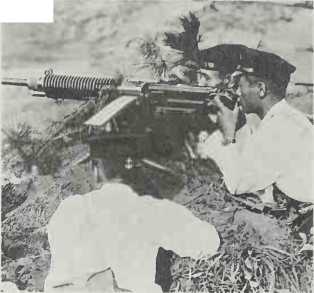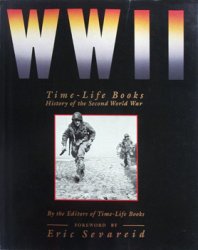At Salerno, 1943, and Anzio, 1944. When Clark took over from Gen Alexander as commander of 15th Army Group in December 1944, Gruenther remained as his cos until the end of the war. Throughout the Italian campaign, Gruenther worked hard to maintain reasonably smooth relations between the able but sometimes brash Clark and his multinational Allies. Postwar, Gruenther was cos at shape from 195153 and Supreme Allied Commander, Europe, 1953-56. PJS.
Grytviken. Old whaling station on South Georgia; scene of Argentine landing on April 3 1982 in the Falklands War.
Guadalajara, Battle of (March 1937), Spanish Civil War. In theory, the Jarama and the Guadalajara offensives were to form Franco’s pincer attack on Madrid, but the Malaga campaign had delayed the redeployment of Mussolini’s 35,000-strong Italian Corps. On March 8, this force of mainly Blackshirt militia, with a Nationalist brigade as flankguard, broke the Republican lines astride the main road to Madrid. Bad weather slowed the advance, giving the Republicans time to rush three divisions forward including the Italian Garibaldi battalion, XII International Brigade). Counterattacking with air and tank support, they put the Blackshirts to flight and recaptured Brihuega. Franco abandoned attacks on Madrid and launched the Vizcaya campaign on German advice. AB.
Guadalcanal campaign (194243). Following the loss of four carriers at Midway, Japan sought to establish a major air base on Guadalcanal, Solomon Islands. On August 7 1942, therefore, the US implemented Operation “Watch-tower”: Rear Adm Turner’s invasion fleet landed some 12,000 men of 1st Marine Division (Maj Gen Vandegrift) at Lunga Point, Guadalcanal, and a further 7,000 Marines on Tulagi and Gavutu islands on the north of Ironbottom Sound (the strait between Guadalcanal and Florida Island; so-called, from late 1942, because of the many ships sunk there). The Japanese (about 2,200 men) abandoned the Guadalcanal airfield
(named Henderson Field by the Americans), which was quickly secured, but the dispersal of Turner’s fleet in the Battle of Savo Island, August 8-9, left the Marines ill-supplied to establish a defensive perimeter under naval and air bombardment. The first Japanese reinforcements from Lt Gen Hyakutake’s Seventeenth Army landed at Taivu, east of Henderson Field, on August 18, but their attack was bloodily repulsed on the Tenaru river, August 21.
US aircraft were operational at Henderson Field from August 20, and the Battle of the Eastern Solomons, August 23—25, further strengthened US air-sea power, forcing Japan to rely on “Tokyo Express” night convoys for reinforcement. After the defeat of Maj Gen Kawaguchi’s assault at “Bloody Ridge”, September 12-14, Hyakutake himself took command; following the naval battle of Cape Esperance, October 11-12, he deployed some 25,000 men around Tenaro, while Vandegrift’s force numbered about 23,000. A major attack across the Matanikau river, October 23-26, by some 5,600 Japanese (3,500 killed) under Maj Gen Maruyama was beaten off, while the naval battle of Santa Cruz, October 25—26, further weakened Japan’s air arm. Vandegrift repulsed Hyakutake’s final attack west of Henderson on November 19-21, while Carlson’s Raiders harried the remaining Japanese in the east.
Japan’s final large-scale reinforcement attempt was defeated in the naval actions off Guadalcanal, November 12-15, and, despite a naval victory at Tassafaronga, November 30-December 1, they were considering evacuation by mid-December, when XIV Army Corps (Maj Gen Patch) relieved Vandegrift’s Marines. Pursued by Patch (who was reinforced following the naval battle of Rennell Island, January 29-30 1943), the Japanese fell back to Cape Esperance, whence some 13,000 survivors were evacuated, January 31-February 7. The Guadalcanal campaign cost the Japanese some
25.000 dead (including around
9.000 killed by disease or starvation in the island’s malarial jungles and swamps) and c600 aircraft; US losses were cl,500 dead and about 4,800 wounded. RO’N.

Japanese naval troops on Guadalcanal
Guadalcanal, naval battles off
(November 12-15 1942). In
November 1942, planning a major offensive on Guadalcanal, Japan stepped up attempts to land reinforcements and to neutralize Henderson Field by bombardment. On the night of November 12-13, Rear Adm Daniel Callaghan (heavy cruisers San Francisco (flagship) and Portland-, three light cruisers; eight destroyers) intercepted Vice Adm Abe’s bombardment force (battleships Hiei and Kirishima-, light cruiser Nagara 11 destroyers) in Ironbottom Sound. Although surface radar located Abe at 15 miles’ (24km) range, poor communications’ discipline lost Callaghan the advantage of surprise. A hectic close-range action resulted in the sinking of light cruisers Atlanta and Juneau and four destroyers and severe damage to Portland. Both Callaghan and Rear Adm Norman Scott were killed. Abe lost Hiei, crippled by gunfire and sunk by aircraft from Henderson Field and the newly arrived uss Enterprise next day, and two destroyers.
On the night of November 1314, as a Japanese supply convoy (Rear Adm Tanaka) headed for Tassafaronga, Vice Adm Gunichi Mikawa’s heavy cruisers bombarded Henderson Field. Twenty US aircraft were destroyed, but air attacks as Mikawa withdrew at dawn sank Kinugasa and damaged Maya and Chokai. Daylight air strikes sank seven of Tanaka’s 11 transports, but he pressed on, hoping for support from Vice Adm Kondo’s approaching bombardment force (battleship Kirishima', four cruisers; nine destroyers).




 World History
World History









